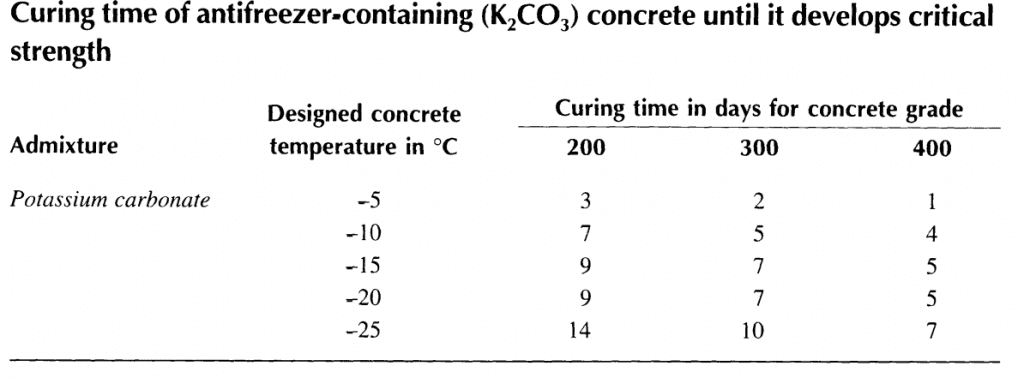An antifreeze admixture is selected according to the design temperature at which concrete is supposed to harden. If the temperature rises above the design value or even becomes positive as the concrete is cured, its hardening will accelerate, and it will attain the design strength earlier than planned.
It is not recommended to expose concrete that has been mixed with antifreeze at an amount intended for a specific hardening temperature to a lower subzero temperature to prevent freezing.
The latter could have negative effects on its qualities after thawing since frost action causes irreversible structural degradation of the material.
The concrete must reach its critical strength by the time of freezing where upon it can be frozen without damage to its structure and properties (Tables 1 and 2).
In this scenario, all that needs to be tolerated is a little delay in the hardening process, or perhaps its complete stoppage if the temperature falls below the design value.
Once the temperature rises and the concrete thaws, the hardening process starts over. If the temperature increases much above the design value, the hardening process accelerates even further, perhaps achieving the design strength earlier than indicated in Tables 1 and 2.
The selection of an antifreeze admixture must be closely coordinated with the composition of concrete, the type of structure, and its environment.
Sodium nitrite
Sodium nitrite may be used in concrete for almost any reinforced concrete structure, but there still some restrictions.
This admixture cannot be used:
- in concretes for prestressed structures reinforced with steel;
- in reinforced concrete structures and joints of precast or cast-in-place structural members that have protruding reinforcement bars or inserts of aluminum-plated steel;
- in reinforced concrete structures designed for service in water or gaseous media with relative humidity over 60% if the aggregate contains inclusions of reactive silica;
- in reinforced concrete structures for electric transportation facilities and for industrial enterprises that use direct current.
It can be seen from the list of restrictions that they do not narrow much the applications of sodium nitrite in reinforced concrete structures.
Potassium carbonate
Potassium carbonate is more restricted in use for concrete and reinforced concrete structures. In addition to the above-listed cases that are not recommended for sodium nitrite, it cannot be used in:
- prestressed structures, in joints with prestressed tendons, and in the channels for the tendons;
- in reinforced concrete structures and joints of precast or cast-in-place structural members that have protruding reinforcement bars or inserts of zinc plated steel;
- in reinforced concrete structures designed for operation in corrosive sulfate waters, in solutions of salts or caustic alkalis when there are evaporating surfaces, and in zones of variable water level.
This list of the cases where potassium carbonate cannot be used, although longer than that for sodium nitrite, still leaves wide room for applications in reinforced concrete structures.
A problem that is often faced in practice is the appearance of efflorescence (traces of salt) on the concrete surface during service. There are many reasons for it and addition of admixtures to concrete is just one of them.
These may be not only antifreezers but also other agents added to impart certain properties to concrete. The efflorescence may be caused by some components of cement, aggregates, or their impurities and it would be wrong to blame the admixtures in this case.
Antifreezers and other admixtures
Antifreezers can be used in combination with other admixtures, such as air-entraining agents, hardening accelerators or retarders, and plasticizers.
Superplasticizcrs are particularly advisable for use with antifreeze admixtures. Studies found that the addition of a superplasticizer together with an antifreezer to a concrete mixture can reduce the amount of the latter nearly by half as compared with that designed for the given predicted temperature of hardening. And the concrete hardens faster and attains the design strength in one or two months.
Some precautions
It is good practice to add an antifreezer to concrete that is to be heated after placing by any method. In a severe frost, a small amount of an antifreeze admixture (2 to 4% by cement weight depending on the ambient air temperature) can protect concrete against some freezing during transportation and placing before the heating is started.
If the antifreezer containing concrete is to be heated with electrodes or electrically preheated, its specific resistance must be checked (it will be lower than that without the admixture) and appropriate adjustments should be made in the layout of the electrodes and in the selection of electric voltage.
The thermal treatment of antifreezer-containing concrete can produce the stripping strength of the concrete in a very short time. The combination of the admixture with heating is particularly effective for concreting in a severe frost when the air temperature drops below 25°C and when antifreeze admixtures alone cannot make the concrete harden at such temperatures. This is especially true for electric contact heating of concrete.
At a very low temperature, placed concrete may freeze quickly as it touches a cold form and electrodes attached to it and the electric heating will become impossible because frozen concrete has a high resistance and the applied voltage will be insufficient to overcome it. An antifreeze admixture depresses the freezing point of the concrete retarding the freezing process and, moreover, reduces the specific resistance of the concrete. In this case we can start the electric heating even if the concrete cooled down below 0°C.
The electric heating of concrete containing an antifreeze admixture makes it possible, under optimum conditions, to produce a compressive strength of 75 to 90% by the time it is completed.
Then the strength of the concrete may increase to 100 or 120% of its design value after 28 days of curing in the frost and 28 days of curing in normal temperature and humidity conditions.
If there is no need to attain this high strength by heating, the thermal treatment time can be reduced considerably at the isothermal curing stage.
Its electric power and increases the turnover of forms while the quality of the concrete remains quite high without sacrificing its basic properties, including tensile strength, the bond with the reinforcement, and frost resistance, as compared with concrete that hardened without electric heating.
Sodium nitrite is recommended as an antifreeze admixture to be added to the electrically heated concrete. Potassium carbonate is inadvisable for such cases because concretes heated with this admixture do not develop strength as planned.
Sometimes it may be lower than the required level by as much as 30%. The frost resistance and water impermeability of such concrete also are low. Concrete with low aluminate Portland cement containing up to 6% C3A in the clinker is preferable for combining electric heating with an antifreeze admixture to avoid the underdevelopment of strength.
Electric heating of concrete containing an antifreeze admixture should be preceded by laboratory tests of specimens made of the same concrete that is to be placed in a structure.
After they are frozen to a subzero temperature, the specimens are electrically heated to determine their strength afterwards as compared with that of a reference specimen.
Read Also:


